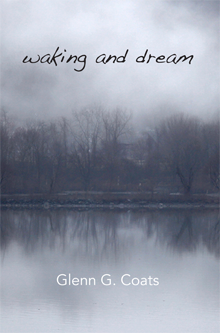Bob Lucky
A Review of Glenn G. Coat's waking and dream
Glenn G. Coats, waking and dream, 78 haibun, 128 pages, 6" x 9", perfect softbound, ISBN: 978-1-936848-82-9, Red Moon Press, 2017.

This is a collection of tender epiphanies, tender in the sense of nostalgic and subtly sentimental, but also tender in the sense of a bruise, the small injuries, emotional and physical, that accumulate over time to define us, or at the very least grind the lens through which we look back over our lives. Memories are the aches that remind us we are alive, and many of the haibun here will resonate with readers in a visceral way. They explore, from different angles and ages, what it is, what it was, to become a man in a particular place and time; the relationship between father and son; and the relationships between man and woman. And there's a fair bit of fishing. There were moments of recognition that made me wince, moments that made me smile, and moments that made me do both simultaneously, as did "While There is Still Time" (p.102):
My father wants to sell
one more door,
hopes to inspect
one more rental unit,
my father longs to catch
one last fish,
fancies a tall glass
of merlot,
hopes to see a comedy
on the big screen,
desires a long rest
on the couch,
when I call
my father's conversation
is brief,
I am not on the list.
nightfall
words to a song darken
then they are gone
The haibun here are in the memoir vein, but the sections are thematic in nature, which breaks up the chronology. This saves the collection from becoming just one damn thing after another, which may be how life is lived, but it's rarely how we remember it. However, there is poetic closure. In the opening haibun the author is in college, and he's still there in the closing haibun. Fittingly, the final section, "Increments," is about death and how we face it, especially how we face the death of others close to us and how we perceive others facing their death (and perhaps how that prepares us for our own). Perhaps it's just me, but of all the ruminations on, and intimations of, death in this section and in the collection in general, one of the most poignant haibun is about the death of a beloved dog, "The Bestowal of Blessings."
waking and dream could serve as a primer of traditional English-language haibun. The majority of the haibun follow the pattern of prose + haiku (one, sometimes two). A half dozen of the haibun have haiku between blocks of prose. Only one opens with a haiku. This sameness sometimes felt monotonous, but I feel my comment is like complaining 'The sonnets in the collection I'm reading invariably have 14 lines.' The exception is the section "Absent Geese," which is comprised of free verse + one haiku. This section also includes the only monostich haiku in the book; all the other haiku are three lines. Again, this is just a way of saying that Coats is a master of the form.
But mastery goes beyond formatting. Coats writes good haiku and he knows how the link and shift between prose and haiku is supposed to work. Many of the haibun I read by writers new to the form fall short in this area. The writers don't understand haiku as a poetic form, and they want to use haiku as a continuation of the prose narrative, that is, there's no link and shift. If you turn to any page of this book and just read the haiku, they stand alone; then you can read them with the prose and rarely do the haiku fail to clearly link and shift in relation to the prose. And his prose is straightforward with a well-polished understatement and hints of a dry sense of humor. If I had to characterize the pace of his prose, or his style, I would call it contemplative. Here's a brief example that illustrates this:
A retired member of the Virginia Circuit Court had just administered
their wedding vows. A few hours later at a small restaurant, a waitress
will look at my parents and ask, "Are you two part of a square dancing
team?"
sunlit stones
the ones that are
meant to be
(from "Prelude," p 82)
Readers of haibun will be familiar with Coats' work as it regularly appears in the journals that publish haibun. Nevertheless, it is nice to have so many in one place and to study how a writer goes about organizing a selection of published haibun into a collection of haibun. There's an art in that too. Readers and writers new to haibun couldn't go wrong giving this book some careful consideration.
waking and dream can be ordered through Red Moon Press. |

